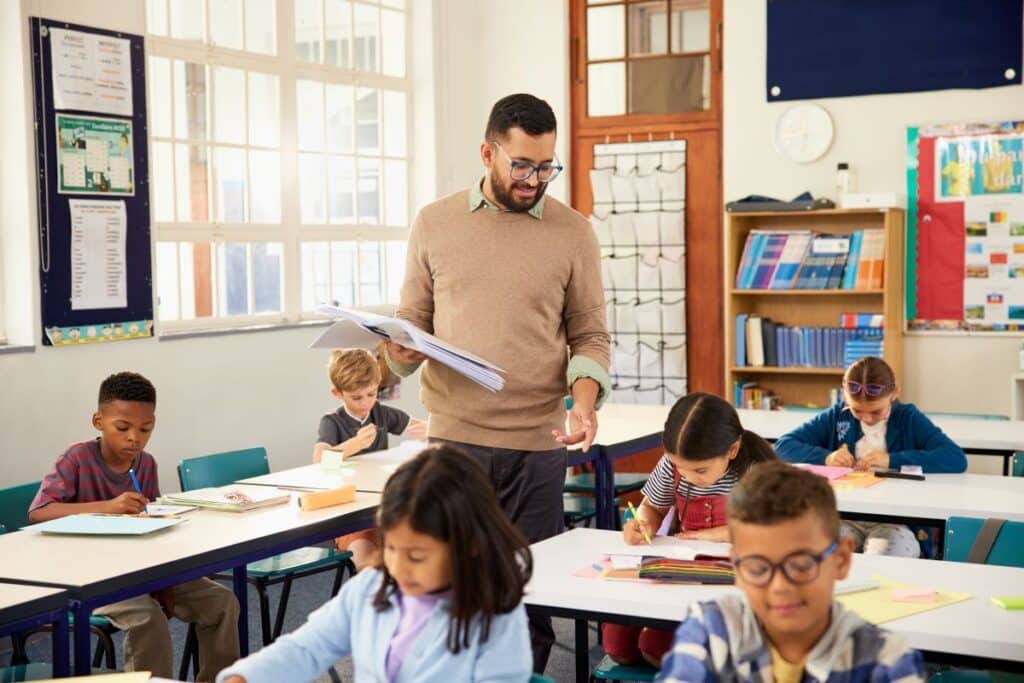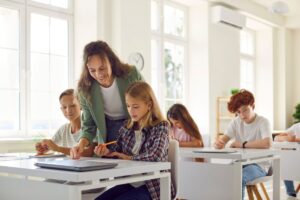One of the most exciting aspects for teachers who love their jobs is to meet the students back for the very first day of the new school year. Students are proud of their shiny new shoes, exciting clothing trends, and immense amount of joy in sharing their stories about summer. It is also a great time of year to establish those expectations for classrooms and the entire school.
Creating a Positive Classroom Environment
One of the most significant actions an educator can perform is to prepare a classroom with optimism. Creating a positive classroom environment will not only welcome students but prepare them for a fun and engaging year, which will enhance their ability to learn and grow.
Providing positive expectations that support appropriate behaviors will provide structure for every student. Understanding how to reteach behavior rather than provide punitive consequences can excite students about attending school. In doing so, academic learning will increase, inclusion of all types of students will occur, and students will begin to take full ownership of their own learning.
One strategy to build this type of atmosphere is always greeting students at the door. Establishing a positive relationship before they even enter the classroom can promote their own sense of well-being, which will then transfer to other students. Knowing one’s students personally can increase their sense of worth and desire to perform at the highest rates of achievement.
Teachers can learn important aspects and details about their students’ lives and share those experiences with them each time they enter the classroom. Nothing excites students at all levels more than being able to share exciting details and updates about those connections. Fostering that connection is the key to success for each student.
Ensuring that content is both engaging and relevant to their lives will also build a positive learning environment. When students can make personal connections to experiences in learning, it commits their understanding to long-term applications, as well as build experiences for problem-solving. If students comprehend the why behind what they are learning, they will be more eager to learn content the next time it is presented.
Effective Behavior Management Strategies
One of the toughest tasks in today’s classrooms pertains to effective behavior management. And the first way to handle this is to build clear and positive classroom expectations. As well, offering positive reinforcement and reteaching expectations is the first step toward being an effective disciplinarian. Providing structure, forming routines, establishing clear directions, and providing stimulating lessons can all affect the ways in which students behave for their teachers.
Yet, the reality is that these strategies will not always guarantee suitable outcomes. So, what else can teachers place in their toolboxes for implementation? Creating a behavior management plan, with the help of students, can provide ownership and pride in the system. Giving choices and rewards for good behaviors and consequences for misbehaviors can help decrease chaotic episodes.
Research shows that students who have a stake in developing a behavior management plan will more often follow the rules and strengthen positive behaviors. Those teachers who model appropriate behaviors or reteach through active situations can support students in consistent and appropriate ways.
In addition, something as simple as not giving a student the class’s attention can provide a pathway for decreasing negative behaviors, once the student figures out that neither the teacher nor the students will pay attention to them. Enhancing this strategy with proximity control and nonverbal communication can also stem some of the negative behaviors.
Teachers who stand near an offender can stymie certain actions, while, at other times, simply focusing on a student who displays negative behaviors without saying a word can give a strong enough implication that they should be not acting in that fashion. Finally, developing a strong classroom layout, based on several factors, such as numbers of females and males in a classroom, academic levels of those students from previous courses or grade levels, an awareness of curriculum connections to other courses, diagnostic pretesting, and physical placement of desks for lessons can control the behaviors of most students.
Building Relationships with Students
Building relationships with students also requires a multitude of strategies. If students feel connected to their schools and faculty and staff members, both their academics and behaviors will deliver positive results. Students who get involved in clubs and activities tend to be more successful, so a teacher who helps connect those students with skills and talents to clubs who can use them to their advantage is a perfect way to build relationships.
Have a student who is proud of his chess abilities? Get him connected with a chess club or help establish one in the school. Have a student who excels at speaking or arguing? Help them locate a debate club or an avenue to present their ideas in a healthy manner. Sometimes, those students exhibiting angry or negative behaviors just need a positive outlet to share or blow off some steam in order to be successful adults.
One mistake often made in the traditional classroom is to be the “sage on the stage.” This approach in talking the majority of the period is no longer an effective approach. Students can become bored or disengaged when teachers talk too much. So, the message is to talk less and become the “guide on the side.” Let students explore content rather than provide formulaic lessons. Eliminate worksheets at times and give students initial information to find their own patterns or interpretations, which can generate far better analytical conversations or, at the very least, provide excitement in trying to apply their own life experiences.
If students enter a classroom never knowing which activity is going to meet them, teachers can generate an excitement and willingness for students to be involved, thus creating an attitude and desire to always be present and ready for learning. Varied lessons and a mix of activities can regulate a powerful learning environment.
One final strategy for educators is to devote time to pedagogical research that helps them not only understand their students but helps provide affirmative ways to handle their students when behaviors begin to affect the classroom environment. Applying numerous strategies for classroom management will make lives easier for teachers and students.
Teachers who know how to identify learning disabilities, spot potential violent behaviors, classify levels of disruptive or defiant behaviors, and categorize students who display withdrawn behaviors will be steps ahead of their peers in controlling a classroom.
Educators are expected to handle so many different roles and responsibilities, ranging from parenting to nursing, that it can become overwhelming to handle their classroom. Students need their teachers to provide positive and safe areas for them to learn, while also pushing them to meet high expectations, which translates into highly successful lifelong learners. Essentially, these strategies will create healthy, successful adults who positively contribute to the world.
Educators never stop learning; check out our available graduate degree programs to hone your skills and promote lifelong learning and academic excellence.




